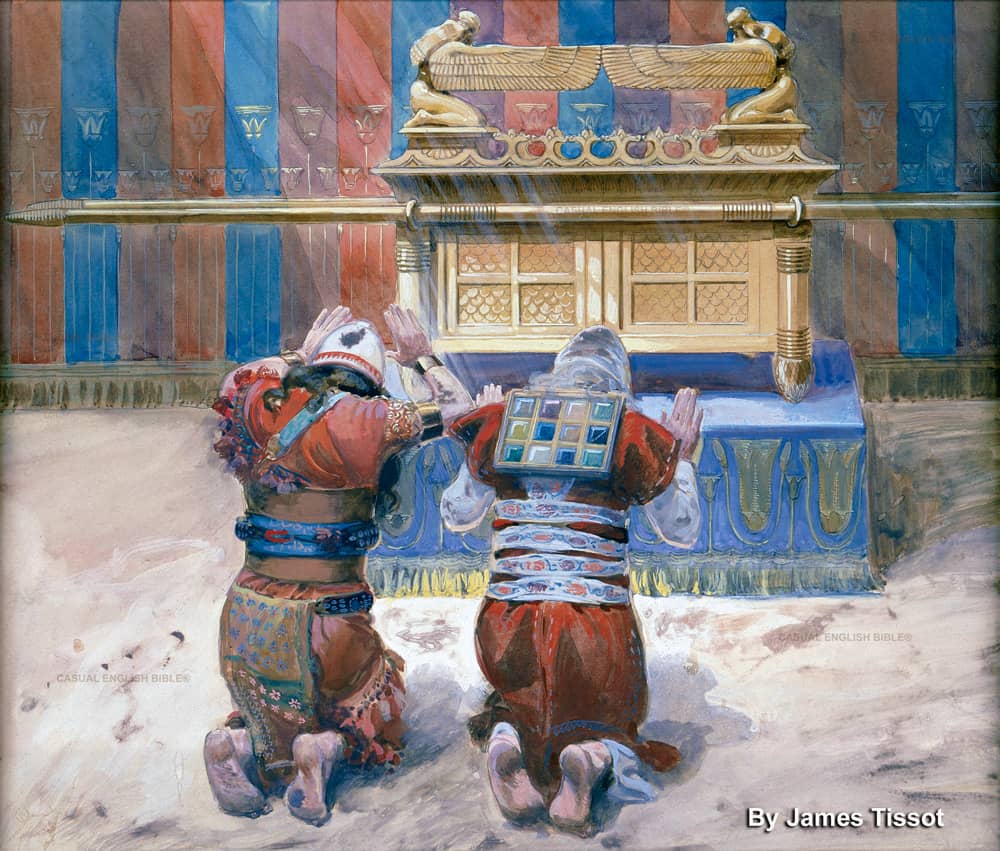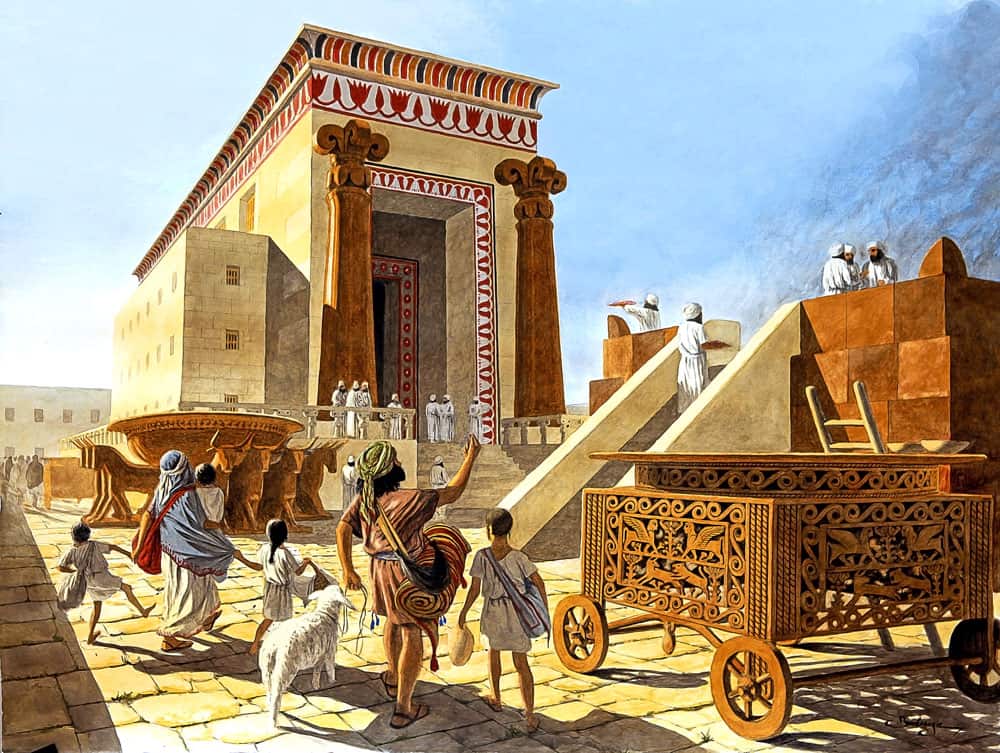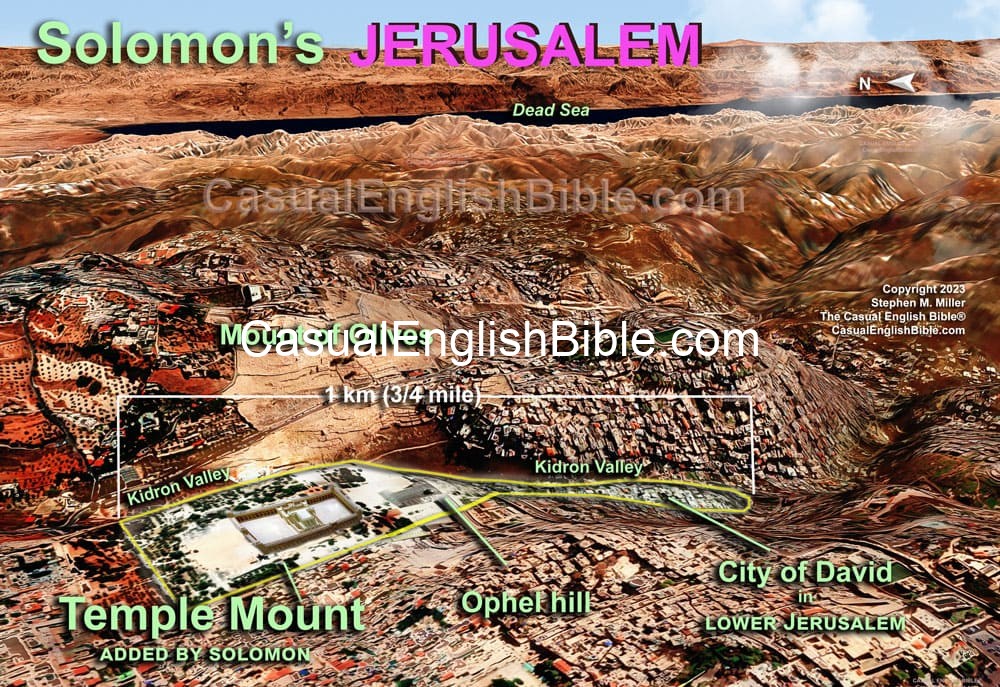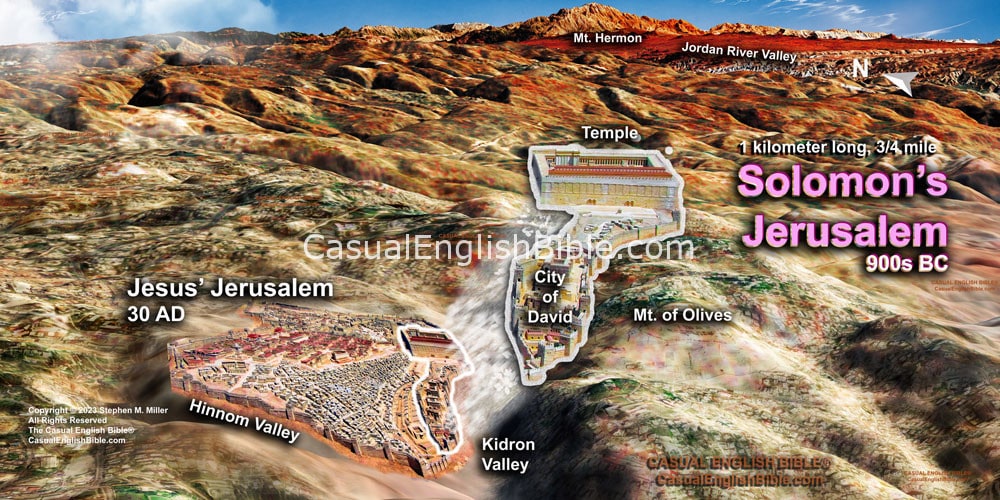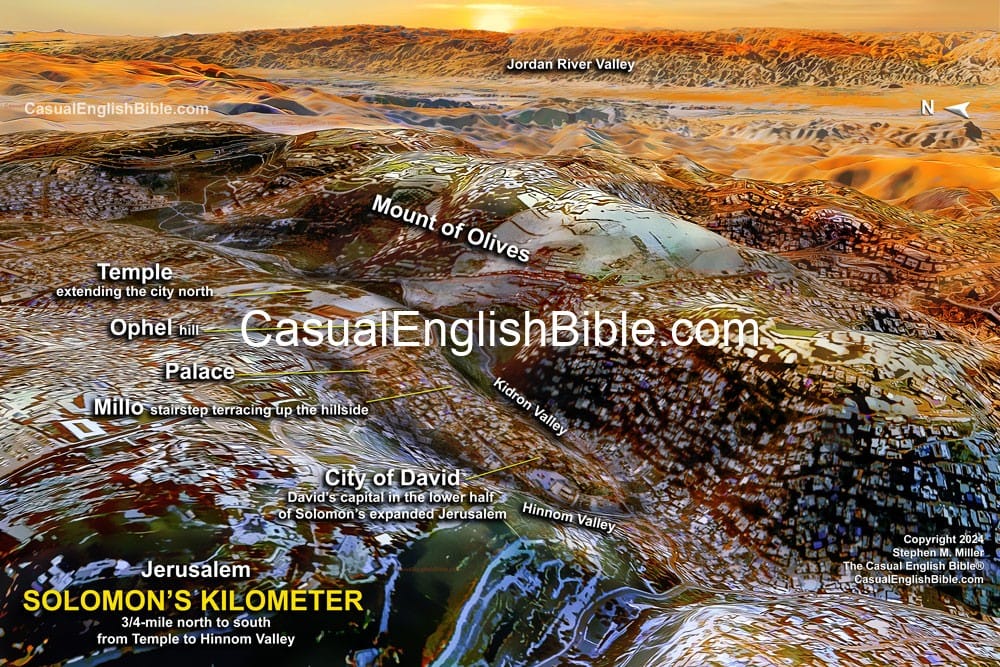2 Chronicles 5
Smoke on the Temple Mountain
Temple construction complete
1When Solomon's workers finished the Jerusalem Temple, he brought in all the furnishings and utensils that his father David had reserved for the Temple, including gold and silver for the Temple treasury.New home for Ten Commandments
1 Kings 8:1-13 2Solomon wanted to move the chest that held the Ten Commandments [1] into the Temple. David had kept the chest in the lower part of the city, known as the City of David or Mount Zion. Solomon called on Israel’s leaders to come to town and join the ceremony. Tribal leaders came, along with many of Israel’s older leaders and heads of extended families.
3It was autumn. Israel’s people came from all over to mark this event during Ethanim, [2] the seventh month on the Hebrew calendar. 4Israel’s leaders came. Priests carried the chest up the hill to the Temple.
5Israel had been worshiping at a tent in the City of David. But now, they moved everything up the hill to the Temple. They brought the chest of the Ten Commandments along with all the tent’s sacred furnishings and utensils. Priests and their associates, the Levites, carried them up the hill. 6King Solomon and the crowd of Israel’s people sacrificed too many cattle and sheep to count.
7Priests carried the chest into the Temple’s holiest room. That was the Most Holy Place, at the back of the Temple’s main room. They set it under the wings of the huge golden cherubim. [3] 8Wings of the cherubim were so large that they provided a covering for the entire chest and the attached poles that priests used to carry it. 9Poles attached to the chest were so long [4] that priests inside the Temple’s main room could see them from the Most Holy Place. But people outside the building couldn’t see them.
10After all these years since the time of Moses, there was nothing inside the chest [5] but the stone tablets Moses put there at Mount Sinai. That’s where God made a contract with Israel. Israel’s first song at the Temple
11Priests inside the Temple’s main room, the Holy Place, came outside. They had gone through the cleaning rituals that Israelite law required for entrance into the worship center.
12Musicians from Israel’s tribe of priests, which was the tribe of Levi, arrived dressed in their fine linen robes. Asaph the musician was there with Heman, Jeduthun and their relatives. They all wore fine linen as they stood east of the altar and sang and played instruments: cymbals, harps, and small harps called lyres. Standing nearby and accompanying them were 120 priests playing ram’s horn trumpets.
13Their job was to make music and thank the LORD. So, they sang and played their horns and cymbals and whatever happy noisemaking instruments they had. In one joyful burst of music they praised the LORD while the singers sang:
God is good.
His love will never let us go
Because God is good forever.
Suddenly, the inside of the Temple filled with a cloud [6] of smoke. 14It became so thick that priests inside couldn’t breathe, let alone perform their ministry. The LORD’s presence filled the Temple, too. Footnotes
15:2Also known as the Ark of the Covenant, Israel’s most sacred relic.
25:3Ethanim falls somewhere between late September and early November. Jews followed the lunar calendar. Then and now, observant Jews celebrate the Festival of Temporary Shelters on the 15th of Ethanim. The festival is often called the Festival of Shelters or Festival of Booths—or Sukkot, among Jewish people today. This was the last harvest festival of the year. That’s when farmers harvested late-season crops such as grapes, figs, and olives (Exodus 23:16). The Hebrew word describing the festival, sukka, can mean tent, canopy, or temporary shelter. Moses said God wanted the Israelites to observe this festival by building temporary shelters and living in them for seven days “so you and your descendants will remember that the people of Israel I led out of Egyptian slavery once lived in shelters like this” (Leviticus 23:43).
35:7These cherubim stood 15 feet high (4 ½ meters) with a wingspan as wide as they were tall. Each wing, to the tip, measured 7 ½ feet, which is about 2 meters (6:23). “Cherubim” is Kerubim in Hebrew. These are celestial beings mentioned throughout the Bible. Ancient Middle Eastern creatures with similar names, such as kirubu, reportedly served other gods. The creatures were portrayed in statues of beings such as human-headed lions with wings. These statues guarded entrances to cities and palaces. Jews taught that God’s footrest was the lid on the Ark of the Covenant, the gold-covered chest that held the Ten Commandments (1 Chronicles 28:2). Two smaller winged cherubim rested on top of the lid, one at each end. That’s in addition to the pair of huge cherubim in the room, standing as though on guard duty for God. Or perhaps waiting for orders to deliver a message.
45:9Bible writers never mentioned how long the poles were. But if they were visible from outside the room where they were kept, they must have been close to 10 yards/meters long. The room was a cube of 30 feet in all directions (6:16).
55:10A New Testament writer said the chest originally held more than the stones. “Inside that chest was a golden jar with some manna, Aaron’s almond wood staff that budded, and stone tablets engraved with the Ten Commandments” (Hebrews 9:4).
65:13The Hebrew word is anan. It can mean: cloud or smoke or morning mist. It seems unclear where the cloud or smoke came from. Perhaps from too much incense or a problem with lamp lighting? Whatever the case, the writer says God somehow used the occasion to let the priests know they weren’t alone.
Discussion Questions
- Sorry, there are currently no questions for this chapter.
Videos
3It was autumn. Israel’s people came from all over to mark this event during Ethanim, [2] the seventh month on the Hebrew calendar. 4Israel’s leaders came. Priests carried the chest up the hill to the Temple.
5Israel had been worshiping at a tent in the City of David. But now, they moved everything up the hill to the Temple. They brought the chest of the Ten Commandments along with all the tent’s sacred furnishings and utensils. Priests and their associates, the Levites, carried them up the hill. 6King Solomon and the crowd of Israel’s people sacrificed too many cattle and sheep to count.
7Priests carried the chest into the Temple’s holiest room. That was the Most Holy Place, at the back of the Temple’s main room. They set it under the wings of the huge golden cherubim. [3] 8Wings of the cherubim were so large that they provided a covering for the entire chest and the attached poles that priests used to carry it. 9Poles attached to the chest were so long [4] that priests inside the Temple’s main room could see them from the Most Holy Place. But people outside the building couldn’t see them.
10After all these years since the time of Moses, there was nothing inside the chest [5] but the stone tablets Moses put there at Mount Sinai. That’s where God made a contract with Israel.
Israel’s first song at the Temple
11Priests inside the Temple’s main room, the Holy Place, came outside. They had gone through the cleaning rituals that Israelite law required for entrance into the worship center.12Musicians from Israel’s tribe of priests, which was the tribe of Levi, arrived dressed in their fine linen robes. Asaph the musician was there with Heman, Jeduthun and their relatives. They all wore fine linen as they stood east of the altar and sang and played instruments: cymbals, harps, and small harps called lyres. Standing nearby and accompanying them were 120 priests playing ram’s horn trumpets.
13Their job was to make music and thank the LORD. So, they sang and played their horns and cymbals and whatever happy noisemaking instruments they had. In one joyful burst of music they praised the LORD while the singers sang:
God is good.
His love will never let us go
Because God is good forever.
Footnotes
Also known as the Ark of the Covenant, Israel’s most sacred relic.
Ethanim falls somewhere between late September and early November. Jews followed the lunar calendar. Then and now, observant Jews celebrate the Festival of Temporary Shelters on the 15th of Ethanim. The festival is often called the Festival of Shelters or Festival of Booths—or Sukkot, among Jewish people today. This was the last harvest festival of the year. That’s when farmers harvested late-season crops such as grapes, figs, and olives (Exodus 23:16). The Hebrew word describing the festival, sukka, can mean tent, canopy, or temporary shelter. Moses said God wanted the Israelites to observe this festival by building temporary shelters and living in them for seven days “so you and your descendants will remember that the people of Israel I led out of Egyptian slavery once lived in shelters like this” (Leviticus 23:43).
These cherubim stood 15 feet high (4 ½ meters) with a wingspan as wide as they were tall. Each wing, to the tip, measured 7 ½ feet, which is about 2 meters (6:23). “Cherubim” is Kerubim in Hebrew. These are celestial beings mentioned throughout the Bible. Ancient Middle Eastern creatures with similar names, such as kirubu, reportedly served other gods. The creatures were portrayed in statues of beings such as human-headed lions with wings. These statues guarded entrances to cities and palaces. Jews taught that God’s footrest was the lid on the Ark of the Covenant, the gold-covered chest that held the Ten Commandments (1 Chronicles 28:2). Two smaller winged cherubim rested on top of the lid, one at each end. That’s in addition to the pair of huge cherubim in the room, standing as though on guard duty for God. Or perhaps waiting for orders to deliver a message.
Bible writers never mentioned how long the poles were. But if they were visible from outside the room where they were kept, they must have been close to 10 yards/meters long. The room was a cube of 30 feet in all directions (6:16).
A New Testament writer said the chest originally held more than the stones. “Inside that chest was a golden jar with some manna, Aaron’s almond wood staff that budded, and stone tablets engraved with the Ten Commandments” (Hebrews 9:4).
The Hebrew word is anan. It can mean: cloud or smoke or morning mist. It seems unclear where the cloud or smoke came from. Perhaps from too much incense or a problem with lamp lighting? Whatever the case, the writer says God somehow used the occasion to let the priests know they weren’t alone.
Discussion Questions
- Sorry, there are currently no questions for this chapter.





